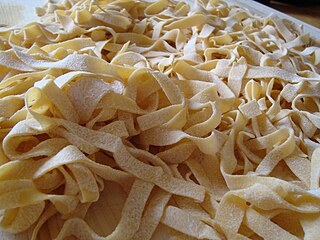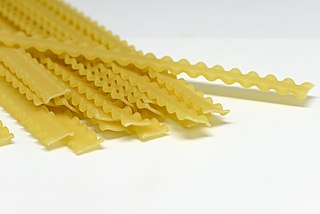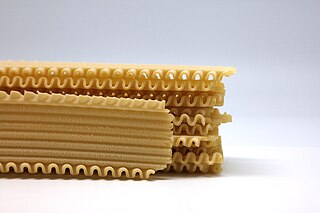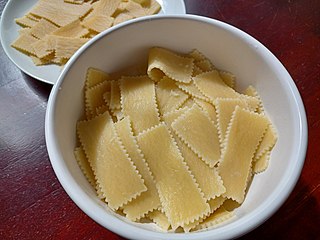
Pasta is a type of food typically made from an unleavened dough of wheat flour mixed with water or eggs, and formed into sheets or other shapes, then cooked by boiling or baking. Rice flour, or legumes such as beans or lentils, are sometimes used in place of wheat flour to yield a different taste and texture, or as a gluten-free alternative. Pasta is a staple food of Italian cuisine.

Spaghetti is a long, thin, solid, cylindrical pasta. It is a staple food of traditional Italian cuisine. Like other pasta, spaghetti is made of milled wheat, water, and sometimes enriched with vitamins and minerals. Italian spaghetti is typically made from durum-wheat semolina. Usually the pasta is white because refined flour is used, but whole wheat flour may be added. Spaghettoni is a thicker form of spaghetti, while spaghettini is a thinner form. Capellini is a very thin spaghetti, sometimes known colloquially as "angel hair pasta".

Carbonara is a Roman pasta dish made with eggs, hard cheese, cured pork and black pepper. The dish took its modern form and name in the middle of the 20th century.

Tagliatelle are a traditional type of pasta from the Emilia-Romagna and Marche regions of Italy. Individual pieces of tagliatelle are long, flat ribbons that are similar in shape to fettuccine and are traditionally about 6 mm wide. Tagliatelle can be served with a variety of sauces, though the classic is a meat sauce or Bolognese sauce.

Fettuccine Alfredo or fettuccine al burro is an Italian pasta dish of fresh fettuccine tossed with butter and Parmesan cheese. As the cheese melts, it emulsifies the liquids to form a smooth and rich cheese sauce coating the pasta. The dish is named after Alfredo Di Lelio, who featured the dish at his restaurant in Rome in the early to mid-20th century; the "ceremony" of preparing it tableside was an integral part of the dish.

Fettuccine is a type of pasta popular in Roman and Tuscan cuisine. It is descended from the extremely thin capelli d'angelo of the Renaissance but is a flat, thick pasta traditionally made of egg and flour. At about 6.5 mm, it is wider and thicker than, but similar to, the tagliatelle typical of Bologna, which are more common elsewhere in Italy and often used as a synonym. Spinach fettuccine is made from spinach, flour, and eggs.

Pizzoccheri are a type of short tagliatelle, a flat ribbon pasta, made with 80% buckwheat flour and 20% wheat flour. They are believed to have originated in Valtellina, a small valley in Lombardy in Northern Italy.

Greenwich Pizza, also known as Greenwich, is a pizza and pasta chain in the Philippines. It was founded in 1971 by Cresida Tueres.

Pappardelle are large, very broad, flat pasta, similar to wide fettuccine, originating from the region of Tuscany. The fresh types are two to three centimetres wide and may have fluted edges, while dried egg pappardelle have straight sides.

Bucatini, also known as perciatelli, is a thick spaghetti-like pasta with a hole running through the center. It is common throughout Lazio, particularly Rome.

Conchiglie, commonly known as "shells" or "seashells", is a type of pasta. It is usually sold in the plain durum wheat variety, and also in colored varieties which use natural pigments, such as tomato extract, squid ink or spinach extract. The shell shape of the pasta allows the sauce to adhere to it. A miniature variety called conchigliette is also available.

Italian cuisine is a Mediterranean cuisine consisting of the ingredients, recipes and cooking techniques developed across the Italian Peninsula and later spread around the world together with waves of Italian diaspora. Some of these foods were imported from other cultures. Significant changes occurred with the colonization of the Americas and the introduction of potatoes, tomatoes, capsicums, maize and sugar beet — the latter introduced in quantity in the 18th century. It is one of the best-known and most appreciated gastronomies worldwide.

Mafaldine, also known as reginette or simply mafalda or mafalde, is a type of ribbon-shaped pasta. It is flat and wide, usually about 1 cm in width, with wavy edges on both sides. It is prepared similarly to other ribbon-based pasta such as linguine and fettuccine. It is usually served with a more delicate sauce.

Ebro Foods, S.A., formerly Ebro Puleva, is a Spanish food processing company. Ebro Foods is the world's largest producer of rice and the second biggest producer of pasta. The company's head office is in Madrid.

Lasagnette is a type of ribbon pasta and a shorter version of lasagnotte. Characteristics of lasagnette differ based on the form of their edges. Different kinds could have edges with a waved cut on both sides, straight cut edges on both side, or a variation including one side with a straight cut and the other with a waved cut. Lasagnette can be prepared in various forms; the two most popular involve a thinner version of the traditional layered Italian lasagna. The second version combines ingredients of the recipe with the pasta, and is served tossed on a plate.
Pillus is a type of pasta found in Sardinia, particularly around Oristano. A noodle-like pasta, it is made in thin ribbon strips. A feature of this pasta is that it is kneaded for a long time. It is cooked in beef broth and served with pecorino cheese. In Busachi the pasta is flavoured with toasted saffron and ground to a powder.

Sagnarelli[saɲɲaˈrɛlli] is a type of ribbon pasta originating in Abbruze. They are typically rectangular ribbons with fluted edges. It is typically served with a cream sauce and their sometimes uneven texture helps to hold thick sauces better.

Bavette[baˈvette] ("bibs") is a type of pasta, a narrower version of tagliatelle. It is a ribbon noodle, similar to spaghetti, that has a flat section and a slightly convex shape. This type of pasta originates in Genoa and is the most typical type of Ligurian pasta cut. Bavette is arguably one of the more ancient types of long pasta. Bavette is highly similar to linguine. Bavette is most frequently paired with traditional pesto sauces, but also pairs well with vegetables.
Premier FMCG (Pty) Ltd, commonly referred to as Premier, is a South African food manufacturer. The company is headquartered in Waterfall City, Johannesburg.

Cascatelli[kaskaˈtɛlli] are a short pasta shape with a flat strip and a pair of ruffles parallel to each other, each of which sticks out at a 90-degree angle from the strip. The ruffles give the shape texture and create a "sauce trough" that holds sauce.

















